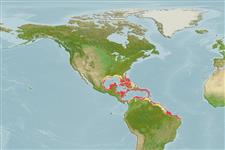>
Ovalentaria/misc (Various families in series Ovalentaria) >
Pomacentridae (Damselfishes) > Microspathodontinae
Etymology: Stegastes: Greek, stegastos, -e, -on = covered (Ref. 45335).
More on author: Poey.
Environment: milieu / climate zone / kisaran kedalaman / distribution range
Ekologi
laut berasosiasi dengan karang; nir-ruaya; kisaran kedalaman 0 - 100 m (Ref. 9626). Tropical; 33°N - 5°S, 98°W - 34°W
Western Atlantic: including southern Florida (USA), Bahamas, and the Caribbean. Probably extending to Brazil (Ref. 9626).
Size / Weight / umur
Kematangan: Lm ? range ? - ? cm
Max length : 10.0 cm TL jantan/; (Ref. 26340)
deskripsi pendek
Kunci identifiaksi (pengenalan) | Morfologi | Morfometrik
Duri punggung (Keseluruhan (total)) : 12; duri punggung lunak (Keseluruhan (total)) : 14 - 17; Duri dubur: 2; Sirip dubur lunak: 13 - 15. Exhibits geographic color variations (Ref. 7247). Body dark in front, becoming abruptly yellow between last dorsal spine and anal fin origin (Ref. 26938).
Body shape (shape guide): fusiform / normal; Cross section: compressed.
Adults inhabit shallow coral reefs and isolated patch reefs in deeper water. Feed primarily on algae but also on polychaetes, hydroids, copepods and ascidians (Ref. 9626). Aggressively territorial but only around a small area (Ref. 9710). Oviparous, distinct pairing during breeding (Ref. 205). Eggs are demersal and adhere to the substrate (Ref. 205). Males guard and aerate the eggs (Ref. 205). Taken incidentally in traps and small-meshed beach nets (Ref. 5217).
Life cycle and mating behavior
Kematangan | Reproduksi, perkembang biakan | Pemijahan | telur-telur | Fecundity | Larva
Oviparous, distinct pairing during breeding (Ref. 205). Eggs are demersal and adhere to the substrate (Ref. 205). Males guard and aerate the eggs (Ref. 205). This species has a juvenile bisexual condition and a typical gonochore testis (Ref. 103751).
Allen, G.R., 1991. Damselfishes of the world. Mergus Publishers, Melle, Germany. 271 p. (Ref. 7247)
Status IUCN Red List (Ref. 130435: Version 2025-1)
ancaman kepada manusia
Harmless
penggunaan manusia
Perikanan: komersial; Akuarium: Komersial
Alat, peralatan
laporan khas
muat turun XML
Sumber internet
Estimates based on models
Preferred temperature (Acuan
123201): 24.2 - 28, mean 26.9 °C (based on 262 cells).
Phylogenetic diversity index (Acuan
82804): PD
50 = 0.5000 [Uniqueness, from 0.5 = low to 2.0 = high].
Bayesian length-weight: a=0.01230 (0.00566 - 0.02674), b=3.06 (2.86 - 3.26), in cm total length, based on LWR estimates for this species & (Sub)family-body (Ref.
93245).
Trophic level (Acuan
69278): 2.0 ±0.00 se; based on food items.
Daya lenting (Acuan
120179): Tinggi, Waktu penggandaan populasi minimum kurang dari 15 bulan (Preliminary K or Fecundity.).
Fishing Vulnerability (Ref.
59153): Low vulnerability (10 of 100).
🛈
Nutrients (Ref.
124155): Calcium = 123 [65, 204] mg/100g; Iron = 0.889 [0.533, 1.467] mg/100g; Protein = 18.2 [17.1, 19.3] %; Omega3 = 0.157 [0.098, 0.256] g/100g; Selenium = 30.7 [16.8, 59.7] μg/100g; VitaminA = 111 [31, 375] μg/100g; Zinc = 2.37 [1.62, 3.37] mg/100g (wet weight);
